Who’s Who in Newspapers? Citizen Genêt edition…
October 10, 2025 by GuyHeilenman · 1 Comment
The 10th installment of Who’s Who in Newspapers
Citizen who? While exploring newspapers from the 18th and early 19th centuries over the past few decades, I noticed the name “Citizen Genet” appearing more than once—always tied to some sort of “affair.” As a novice historian at the time (my academic background is actually in mathematics and engineering), and given my aversion to sensationalized “yellow journalism,” I let it pass. With tens of thousands of fascinating topics to explore through our beloved collectible, I never stopped to uncover who he really was or what his “affair” involved.
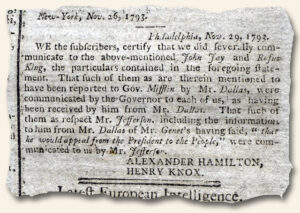 Recently, however, I embraced the old adage that “it’s never too late to learn” and finally took the plunge. What I found was a story worth the effort, one that offered both historical insight and a better appreciation for the newspapers that recorded it. A summary of my discovery is as follows:
Recently, however, I embraced the old adage that “it’s never too late to learn” and finally took the plunge. What I found was a story worth the effort, one that offered both historical insight and a better appreciation for the newspapers that recorded it. A summary of my discovery is as follows:
Edmond-Charles “Citizen” Genet was a French diplomat sent to the United States in 1793 to gain American support for France’s wars with Britain and other European powers. Instead of observing diplomatic protocol, he jumped right into recruiting privateers to attack British ships and encouraging Americans to take up arms against Spain. These moves directly violated President George Washington’s Neutrality Proclamation of 1793. To make matters worse, Genet bypassed Washington altogether and appealed directly to the American public, an act that came across as both disrespectful and threatening to U.S. sovereignty.
The uproar that followed—known as the “Citizen Genet Affair”—quickly became a defining moment in America’s early history. Washington demanded Genet’s recall, reinforcing both the president’s authority in foreign affairs and the new nation’s commitment to neutrality. At home, the controversy deepened political divisions: Federalists supported Washington’s cautious stance, while Democratic-Republicans sympathized with revolutionary France. In the end, Genet was granted asylum in the United States and lived out his life in New York, but his story left behind a lasting lesson in diplomacy and America’s determination to remain independent from foreign influence.
So much for jumping to conclusions regarding his “affair”. I should have known better.
The photos shown are from two articles within the Columbian Centinel, Dec. 11, 1793. – the above in full, and the below of only an excerpt due to the length of the article. If original newspapers on this topic remain available, they would be found at: CITIZEN GENET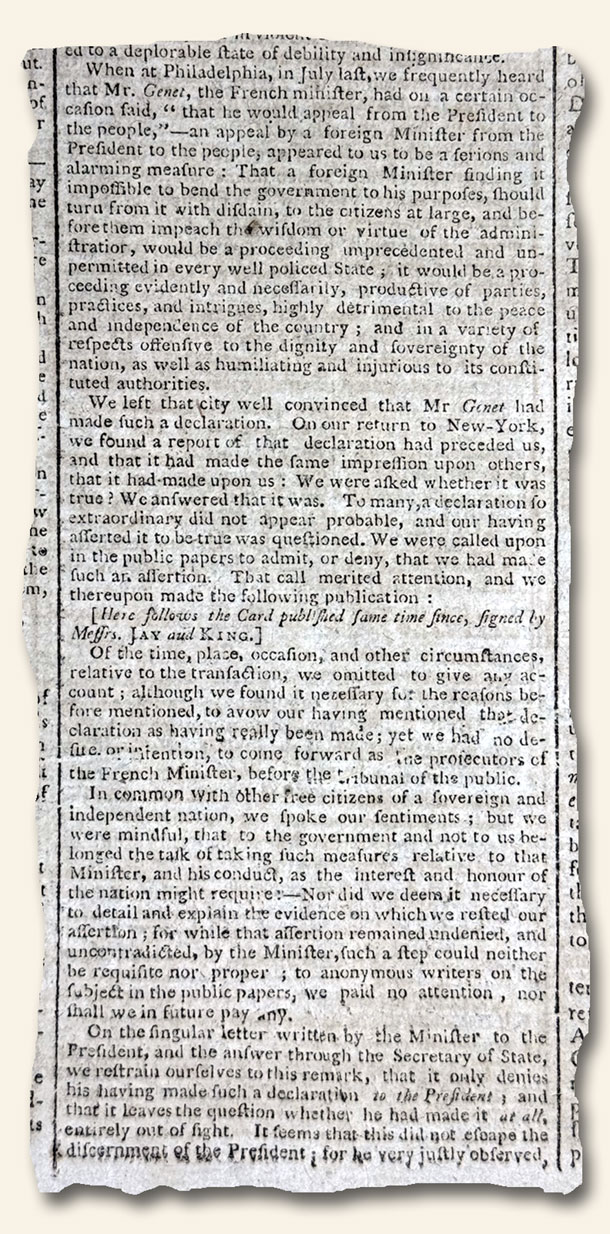
The many views of Niagara Falls – inspirating wood-cut illustration…
September 26, 2025 by Laura Heilenman · Leave a Comment
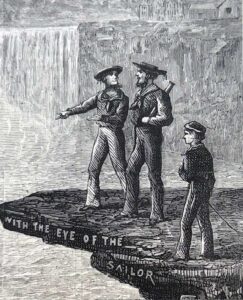 Decades ago, when my husband and I called Lancaster County, Pennsylvania, our home, we were immersed in a world where the Amish community was a constant presence – their simple way of life woven into the fabric of our daily existence. For fourteen years, we lived among the rolling farmlands, the clip-clop of horse-drawn buggies, and the quiet resilience of a people who shunned modern conveniences. Yet, despite this proximity, we rarely partook in the activities that drew countless visitors to Lancaster County’s doorstep. We never sat at an Amish family’s kitchen table, savoring a meal steeped in tradition. We never climbed aboard a buggy for a leisurely ride through the countryside, nor did we ever step foot in Dutch Wonderland – that colorful amusement park that beckons tourists with its promise of family-friendly thrills.
Decades ago, when my husband and I called Lancaster County, Pennsylvania, our home, we were immersed in a world where the Amish community was a constant presence – their simple way of life woven into the fabric of our daily existence. For fourteen years, we lived among the rolling farmlands, the clip-clop of horse-drawn buggies, and the quiet resilience of a people who shunned modern conveniences. Yet, despite this proximity, we rarely partook in the activities that drew countless visitors to Lancaster County’s doorstep. We never sat at an Amish family’s kitchen table, savoring a meal steeped in tradition. We never climbed aboard a buggy for a leisurely ride through the countryside, nor did we ever step foot in Dutch Wonderland – that colorful amusement park that beckons tourists with its promise of family-friendly thrills.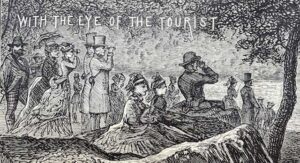
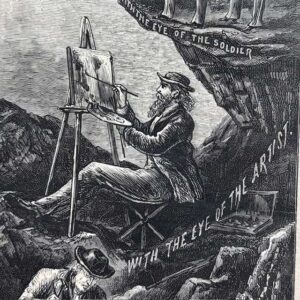
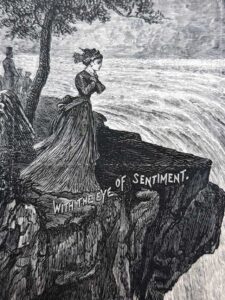 If we could train ourselves to view our surroundings through multiple sets of eyes—through the curious gaze of a child, the weathered perspective of an elder, or the fresh wonder of a newcomer—what richness we might uncover. Imagine the billions of impressions we could gather, each one a thread in the tapestry of our experience, pulling us toward the next moment with a heightened sense of anticipation and urgency. To live this way, with eyes wide open to the infinite possibilities around us, would be to embrace a life brimming with discovery, where every step forward is an invitation to marvel at the world anew.
If we could train ourselves to view our surroundings through multiple sets of eyes—through the curious gaze of a child, the weathered perspective of an elder, or the fresh wonder of a newcomer—what richness we might uncover. Imagine the billions of impressions we could gather, each one a thread in the tapestry of our experience, pulling us toward the next moment with a heightened sense of anticipation and urgency. To live this way, with eyes wide open to the infinite possibilities around us, would be to embrace a life brimming with discovery, where every step forward is an invitation to marvel at the world anew.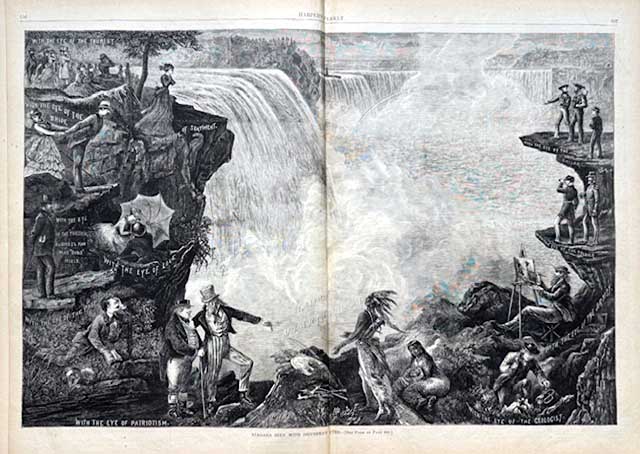
Inspiration Surrounds Us… Illustrated Prints for Framing…
July 28, 2025 by Laura Heilenman · Leave a Comment
 Without a doubt, you would want a love of history to enjoy working here at RareNewspapers. If history enthralls you, being surrounded by first account history is beyond delightful. While not everyone is able to join us on a daily basis, here in the archives, we all have the ability to surround ourselves with images from the past that inspire & encourage as well as teach & caution. With this in mind, I wanted to share some new 1900’s LESLIE’S ILLUSTRATED & SATURDAY EVENING POST magazines with you as they are replete with captivating images… both stark and winsome. I have attached a few of the most recent listings below for your enjoyment. As you can see from the frame hanging next to my desk, even those tattered and torn images can find new life with a little TLC.
Without a doubt, you would want a love of history to enjoy working here at RareNewspapers. If history enthralls you, being surrounded by first account history is beyond delightful. While not everyone is able to join us on a daily basis, here in the archives, we all have the ability to surround ourselves with images from the past that inspire & encourage as well as teach & caution. With this in mind, I wanted to share some new 1900’s LESLIE’S ILLUSTRATED & SATURDAY EVENING POST magazines with you as they are replete with captivating images… both stark and winsome. I have attached a few of the most recent listings below for your enjoyment. As you can see from the frame hanging next to my desk, even those tattered and torn images can find new life with a little TLC.
LESLIE’S WEEKLY, New York, January 11, 1919.
LESLIE’S ILLUSTRATED, New York, February 7, 1920.
LESLIE’S ILLUSTRATED, New York, March 23, 1918.
Snapshot June, 1875 – Winslow Homer…
June 16, 2025 by GuyHeilenman · Leave a Comment
Just for fun, I searched through our listings (RareNewspapers.com) to see what interesting events made the news during the month of June from 150 years ago. Honestly, I was slightly underwhelmed. My next step was to search On This Day’s website to see if perhaps we had missed any significant events. Again, and with sincere apologies to anyone who might know of something “newsworthy” which occurred during this timeframe, I think I dosed off once or twice while reading through the list – and it was relatively short. Not prone to raising a white flag prematurely, I made one last attempt adding the key word “newspapers” to my inquiry, and there it was. While my “find” may not be interesting to most, it certainly was to our beloved collectible:
Winslow Homer’s last print for Harper’s Weekly appeared within the issue dated June 26, 1875 – 150 years ago this month. After such wonderful contributions as his “Beardless Lincoln”, “Gathering Berries”, “Snap the Whip”, “Waiting for a Bite” and more, what might he chose to illustrate for his final curtain call? A tribute to those who put their lives on the line for the sake of freedom. Shown below is his “Battle of Bunker Hill–Watching the Fight From Copp’s Hill, In Boston”.
Thanks Winslow. You certainly did your part to help immortalize key events and unique personalities from the mid/late 1800s.
Does anyone know about this obscure Thomas Nast print from 1877?
June 6, 2025 by TimHughes · 3 Comments
Amongst our holdings is an obscure newspaper called “The People” from New York City, dated November 3, 1877. A closer look notes this is the volume 1, number 1 issue, and more curiously, we can find nothing about this newspaper online. This may be the only issue published, and with no mention of it in Gregory’s “Union List of American Newspapers” one wonders whether any institution is aware it even exists.
Compounding this obscurity is the large comic illustration (shown below) of John Morrissey, done by the famed artist Thomas Nast, verified by a small front page article headed: “Our Cartoon”. It verifies: “The accompanying admirable portrait of Our Great Municipal Reformer is one of the earliest made by Nast, and cost $100. It was engraved by a peculiar process which reversed the artist’s signature; but by holding it before the glass the Nast’s familiar handwriting will be recognized.”
Nothing can be found online of the existence of a Thomas Nast print captioned as noted above, let alone being in a newspaper titled: “The People”. With as much academic research that has been on this famed political artist, I find it interesting that nothing seems to be known of it.
So I reach out to all the Thomas Nast scholars, collectors, and admirers. Is anything out there that we are missing as to the existence of this print? Photos accompany this post. It exists; we just want to know more, and hopefully someone can be of help.
The reason I collected it: the perfect logo for the company…
June 2, 2025 by TimHughes · Leave a Comment
When I began this company back in 1975, my offerings were simply typed lists of newspapers I had recently purchased. When an issue sold, I cut it out, added new ones to the bottom of the list, made photocopies of the 8 1/2 by 14 sheets, and mailed them to those expressing interest.

I later evolved my offerings into a small catalog, essentially 8 1/2 by 11 sheets folded in half resulting in 16 pages of 5 1/2 by 8 1/2 inches. I wanted a logo for the cover that would represent what I was selling. Not finding anything magical, I opted for a print of a colonial printing press. Perhaps some of you still have some of those old catalogs featuring the printing press.
But a printing press was too generic. It was not specific to newspapers; books, pamphlets, broadsides–anything with ink–were printed on a printing press. So my quest for a more perfect image continued.
Back in the late 1900’s I was doing research on a collection of the “Illustrated London News“, the model that would be followed by Leslie’s Illustrated, Harper’s Weekly, and a host of other illustrated newspapers. On the back page of an issue from 1862 there was a brief article titled: “The Newsboy“ and it was accompanied by a great print of a young newsboy offering a newspaper (shown below). It was the perfect find. It had an old-time look (it was from 1862 after all), it was specific to newspapers, and it had a generally pleasant appearance that I thought would work well as a logo.
And so it became the framework for our logo (shown to the right above). You will find it front & center on our website and on any number of printed pieces we produce each year. So if you’ve ever wanted how it was created, perhaps appropriately, it came from an old newspaper.
Who’s Who in Newspapers – Robert Smalls edition…
March 3, 2025 by GuyHeilenman · Leave a Comment
The 9th installment of Who’s Who in Newspapers
Let’s explore for a moment. Would you leave your small child alone in your car with the engine running? Might you ask your best friend, who happens to be a recovering alcoholic, to watch your house – and especially your liquor cabinet, while your family is on vacation? Would you have your dog guard the steaks you’re grilling so you can take a bathroom break? Continuing in the food category (yes, I’m hungry), would you leave a tray of fresh-baked cookies out in the open during your 5-year-old’s birthday celebration and leave for 30 minutes expecting all would still be present upon your return? I’m guessing the answer to all of the above would be a resounding “NO, of course not.” In fact, “What were you thinking?” would be any observer’s reasonable response.
How about this one? If you were the captain of a confederate vessel holding a number of “quite capable” slaves, would you and a large portion of the crew leave them unshackled and largely unguarded so you could enjoy a bit of shore-leave? Before you say, “No capta07in would be so foolish”, it would be worth your time to read about Robert Smalls‘ and his enslaved companions’ escape from the Charleston Harbor on the USS Planter during the Civil War. An article printed in the New-York Tribune date May 24, 1862 is shown below. However, after (hopefully) enjoying the article, it might be worth your time to read more about the event and this fascinating man. Two possibilities are the brief summary found on Wikipedia and/or author Cate Lineberry’s, “Be Free or Die: The Amazing Story of Robert Smalls’ Escape from Slavery to Union Hero“. Once again, I am grateful much about him was chronicled in the newspapers of his day – making him an easy edition to “Who’s Who in Newspapers”.

Snapshot 1871 – Yosemite Edition…
February 10, 2025 by GuyHeilenman · Leave a Comment
Snapshot 1871…
Well, perhaps technically not a snapshot, but certainly an 1870’s version of such – an amazing woodcut illustration of one of my wife’s and my favorite places to visit:

Sandwiched at the midpoint of the timeline between the Mariposa War and when Yosemite National Park was established, this 1871 print of the Yosemite Valley captures the essence of its unspoiled grandeur. To read the corresponding article written by one who had just recently explored the region, go to:
“The Cub”, November, 1871
This publication describes itself as: “An Amateur Journal devoted to the interests of Boys and Girls”. As I tried to place myself in the shoes of a 19th century boy reading the article after viewing the illustration, I was reminded of the 1st time my wife and I beheld the valley for the 1st time. Standing from a perch atop Glacier Point – a location which enables one to drink in much of the Yosemite Valley in one visual snapshot, my childlike wonder came bursting forth from some long-buried place within, and my spirit cried out in praise to the One who created such things merely for our pleasure. What a memory!
Who’s Who in Newspapers? Denmark Vesey edition…
December 16, 2024 by GuyHeilenman · Leave a Comment
The 8th installment of Who’s Who in Newspapers
Denmark Vesey… Certainly not a household name, but how about Frederick Douglass, John Brown, and Nat Turner? These and more credit the Denmark Vesey incident (a planned slave revolt) as a key cog in their inspiration to risk their lives in order to help free the Southern slaves. The Niles’ Register dated July 13, 1822 contains the following is a brief article regarding the fate of those involved:
Douglass used Vesey, a free black man, as a rallying cry to recruit Black men to fight in the Union Army during the Civil War by declaring, “Remember Denmark Vesey of Charleston”. Vesey’s plot to arm enslaved people against their enslavers and temporarily liberate Charleston inspired abolitionists and fueled anti-slavery activity throughout the United States – many viewing him as a hero and martyr for freedom.
Note: In total, the courts convicted 67 men of conspiracy and hanged 35, including Vesey, in July 1822. Thirty-one men were deported, 27 were reviewed and acquitted, and 38 were questioned and released. You can read more about the incident itself at: The Denmark Vesey Incident.
Finding the Unexpected… Village Voice edition…
September 30, 2024 by GuyHeilenman · Leave a Comment
The Village Voice is known for many things, but articles which take a deep-dive into the history of the United States is not among them. So, when I came across a highlighted quote from Abraham Lincoln from his 1865 Inaugural Address within the issue dated July 12, 1976, my curiosity was piqued. Rather than describe my findings in words, I think it best to let the pictures (photos) below do the talking. If you are familiar with this publication, I hope you are intrigued about their presence as well. Enjoy.





Note: The Village Voice did a reflective article on this issue on June 28, 2023 which can be viewed here: Last Refuge of a Rock Critic…




